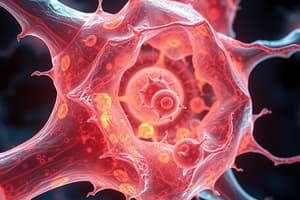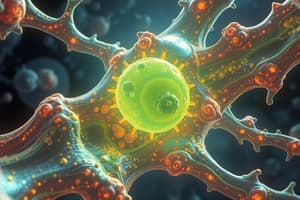Podcast
Questions and Answers
Smooth muscle cells are striated and voluntary muscle cells.
Smooth muscle cells are striated and voluntary muscle cells.
False (B)
Osteocytes are a type of muscle cell responsible for maintaining the bone matrix.
Osteocytes are a type of muscle cell responsible for maintaining the bone matrix.
False (B)
Red blood cells are primarily responsible for transporting oxygen in the body.
Red blood cells are primarily responsible for transporting oxygen in the body.
True (A)
The smooth muscle tissue lines body cavities and forms the walls of many organs.
The smooth muscle tissue lines body cavities and forms the walls of many organs.
Bone cells have the ability to differentiate into smooth muscle cells.
Bone cells have the ability to differentiate into smooth muscle cells.
Involuntary muscles are under conscious control.
Involuntary muscles are under conscious control.
Smooth muscle cells can be found in the airways of the lungs.
Smooth muscle cells can be found in the airways of the lungs.
Osteoblasts are immature bone cells that help assemble the bone matrix.
Osteoblasts are immature bone cells that help assemble the bone matrix.
Skeletal muscle cells are covered by connective tissue, which supports the muscle bundles.
Skeletal muscle cells are covered by connective tissue, which supports the muscle bundles.
Cardiac muscle cells are responsible for voluntary movements in the body.
Cardiac muscle cells are responsible for voluntary movements in the body.
Muscle cells provide structural integrity but do not play a role in energy storage.
Muscle cells provide structural integrity but do not play a role in energy storage.
The main function of skeletal muscle cells is to aid in involuntary functions like heartbeat.
The main function of skeletal muscle cells is to aid in involuntary functions like heartbeat.
Cardiac muscle cells help synchronize the heartbeat.
Cardiac muscle cells help synchronize the heartbeat.
Muscle cells are only found in the heart and are not present in other parts of the body.
Muscle cells are only found in the heart and are not present in other parts of the body.
Myocytes are another name for muscle cells.
Myocytes are another name for muscle cells.
Connective tissue does not have any role in the support of muscle cells.
Connective tissue does not have any role in the support of muscle cells.
Channel proteins allow certain molecules to pass through the cell without any assistance.
Channel proteins allow certain molecules to pass through the cell without any assistance.
The cytoskeletal elements are primarily made of actin protein, which is the thickest type of fiber in the cytoskeleton.
The cytoskeletal elements are primarily made of actin protein, which is the thickest type of fiber in the cytoskeleton.
Microfilaments play a crucial role in maintaining cell shape and facilitating the movement of organelles.
Microfilaments play a crucial role in maintaining cell shape and facilitating the movement of organelles.
Carrier proteins change shape to transport specific molecules across the membrane.
Carrier proteins change shape to transport specific molecules across the membrane.
Cell recognition proteins help in the detection of nutrients entering the cell.
Cell recognition proteins help in the detection of nutrients entering the cell.
The lipid bilayer's selective permeability means all molecules can freely enter or exit the cell.
The lipid bilayer's selective permeability means all molecules can freely enter or exit the cell.
Intermediate filaments are involved in anchoring the nucleus and maintaining cell shape.
Intermediate filaments are involved in anchoring the nucleus and maintaining cell shape.
Receptor proteins bind with molecules to trigger specific cellular responses.
Receptor proteins bind with molecules to trigger specific cellular responses.
Study Notes
Cell Types
- Somatic cells undergo mitosis for growth and repair, while germinal (sex) cells undergo meiosis for reproduction.
- Stem cells are unique, unspecialized cells with the potential to differentiate into various cell types.
Bone Cells
- Osteoid is the organic substance found in the bone matrix, essential for bone structure.
- Types of Bone Cells:
- Osteoclasts: Multinucleate cells that decompose bone, secrete acids and enzymes to dissolve the bone matrix, and aid in nutrient assimilation.
- Osteoblasts: Immature bone cells that secrete organic components of the bone matrix.
- Osteocytes: Mature bone cells responsible for maintaining the bone matrix.
Blood Cells
- Red Blood Cells (Erythrocytes): Transport oxygen and contain approximately 5 million cells per blood sample; their structure is concave and crucial for oxygen delivery.
- White Blood Cells (Leukocytes): Fight infections and consist of various types:
- Neutrophils: 40-70% of WBCs, act as key immune defenders.
- Lymphocytes: 18-42% of WBCs involved in adaptive immunity.
- Monocytes: Alert other cells to invaders and help in pathogen destruction.
- Platelets: Assist in blood clotting to prevent excessive blood loss.
Muscle Cells
- Smooth Muscle Cells: Non-striated, involuntary muscle lining body cavities and organs such as kidneys and blood vessels.
- Skeletal Muscle Cells: Covered by connective tissue, involved in voluntary movement.
- Cardiac Muscle Cells: Involuntary muscle in the heart responsible for synchronized heartbeat.
Nerve Cells (Neurons)
- Neurons send signals within the nervous system through nerve impulses, consisting of:
- Cell Body: Contains neuron components.
- Nerve Processes: Projections that conduct signals.
Endothelial Cells
- Form the inner lining of cardiovascular and lymphatic systems, playing a critical role in blood circulation.
Roles of Lipid Bilayer
- Selective permeability allows certain molecules to enter or exit cells, regulating internal environments.
- Channel Proteins: Provide passageways for specific molecules.
- Carrier Proteins: Change shape to transport molecules across the membrane.
- Cell Recognition Proteins: Detect invading pathogens.
- Receptor Proteins: Trigger cellular responses through molecule binding.
Cytoskeletal Elements
- The cytoskeleton consists of long protein fibers that provide structural support and facilitate cellular movement.
- Includes Microfilaments (thinnest fibers aiding in shape and movement) and Intermediate Filaments (maintaining cell shape and anchoring the nucleus).
Studying That Suits You
Use AI to generate personalized quizzes and flashcards to suit your learning preferences.
Related Documents
Description
Explore the fundamental differences between somatic and germinal cells, as well as the role of stem cells in differentiation. Delve into the various types of bone cells, including osteoclasts and their functions in bone maintenance. This quiz tests your knowledge on cell biology and bone structure.




